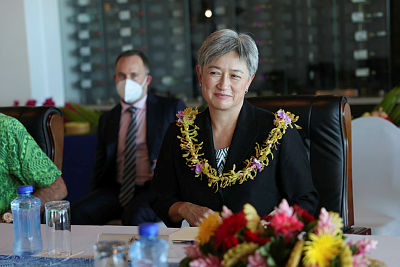Australian officials have sounded the alarm about rising debt levels and economic “fragility” among Pacific countries amid increasing competition with China for influence.
On Tuesday the Australian government will publish the first update of its international development policy in a decade, with a focus on the Pacific, south-east Asia and south Asia.
The policy is not backed by any new foreign aid funding, but the government wants to use “blended finance” tools to encourage the private sector to lend money, especially for climate-related projects in south-east Asia. The government will announce a new $250m (US$164 million) fund for this purpose.
Australia will seek to play to its perceived strengths across the region, including by pledging “genuine partnerships based on respect, listening, and learning from each other” and to ensure loans don’t create “unsustainable debt burdens”.
The government’s policy document includes a stark warning that public debt in the Pacific is expected to almost double by 2025 compared with 2019, with the cost of interest repayments eroding frontline services.
“The increase in the debt servicing burden will exacerbate challenges and impact critical health, education, and social services,” the report warns.
“We will support each nation in their endeavours to unlock new avenues to prosperity, including as they empower women and girls, enhance digital connectivity and diversify trade on global markets.”
The report does not mention China directly, but warns that “geostrategic competition is exacerbating existing vulnerabilities and threatens stability”.
Guardian Australia understands the Australian government is mindful that China will use every avenue to increase its influence, including through security and police cooperation deals.
Australia plans to press its own advantages and competitive strengths – including people-to-people links – to try to remain the “partner of choice”.
This will include a desire to avoid fly-in fly-out workforces – a practice that has sometimes been a source of complaint about China’s approach to infrastructure projects. Australian will seek to maximise “local content”.
The minister for international development and the Pacific, Pat Conroy, said: “We will invest in local solutions that deliver a double dividend – creating local jobs and delivering direct economic benefits on the ground, while also improving the development impact of Australia’s investments.”
The policy describes gender equality, climate change and disability equity as core issues.
It acknowledges the need to “respond to the calls of our region and evidence of the accelerating climate crisis by increasing our climate investments and better addressing climate risks” but is silent on Australia’s own coal and gas policies.
From next financial year, at least half of all new bilateral and regional investments valued at more than $3m (US$1.9 million) will have a climate change objective, with a goal of reaching 80 percent by 2028–29.
Likewise, 80 percent of investments must “address gender equality effectively”.
The government gave an advance briefing to the development sector on Monday.
The chief executive of the Development Intelligence Lab, Bridi Rice, said Australia’s approach over the past decade had been “characterised by reactive plays aimed at short-term tactical outcomes, like outbidding China or burnishing Australia’s image at a cost to development results”.
“This new policy, by contrast, is a clear statement of intent,” Rice said.
“This policy sets out a good faith, transparent and long-term approach to development that can help create a peaceful, stable and prosperous region – which serves Australia’s national interests far better than using the aid budget as a slush fund.”
The chief executive of the Australian Council for International Development, Marc Purcell, said development was increasingly seen as an important geopolitical lever, but its top purpose must be to alleviate poverty.
The government is likely to disappoint the sector by not promising extra funds or committing to a clear timeframe to achieving a target of international development reaching 0.5 percent of gross national income.
The government is expected to blame broader budget pressures, even though the Labor party platform still includes the 0.5 percent goal.
The report says the overall objective of Australia’s development program is “to advance a peaceful, stable, and prosperous Indo-Pacific region” but this will require agility, focus and discipline.
It says 22 of Australia’s 26 nearest neighbours are developing countries “and some remain fragile”.
“Progress has been uneven and can be eroded quickly, as shown by the pandemic. Corruption, fragility and poor governance continue to hold some countries back.”
The foreign affairs minister, Penny Wong, said Australia was “using all elements of our national power to advance our interests and shape the world for the better.”
“This new policy reflects who we are. Australia is there, not only in times of crisis, but is working with the region to strengthen its resilience and to help deliver its aspirations,” she said.
SOURCE: THE GUARDIAN/PACNEWS














